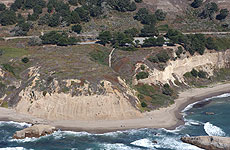May 2, 2005
Are Santa Cruz beaches destined to shrink?
By Françoise Chanut
Wide sand beaches are a prized feature of Santa Cruz and other
communities along the northern coast of Monterey Bay. But are
they just a temporary aberration, destined to shrink in the
years to come?

Beach width has decreased significantly in the area
around Greyhound Rock, 3 miles south of Año Nuevo,
over the past 30 years.
Photo: Copyright © 2002-2004
Kenneth & Gabrielle Adelman, California Coastal Records
Project, www.californiacoastline.org
|
That is the hypothesis championed by Gerald Weber, lecturer
emeritus in the Department of Earth Sciences and a consulting
geologist.
According to Weber, northern Monterey Bay beaches have been
kept abnormally wide over the past 200 to 300 years by an excess
of sand drifting down the coast from a large temporary source
north of Año Nuevo. That source is now exhausted.
Beaches just south of Año Nuevo have already shrunk
in the past 30 years, and Weber said he expects that trend to
spread slowly south to Santa Cruz and beyond.
"Beaches down drift from Point Año Nuevo have shrunk
drastically over the past 25 to 30 years, and sea-cliff erosion
is accelerating," Weber said.
Other geologists, however, do not anticipate dramatic changes.
Gary Griggs, professor of Earth sciences and an expert on coastal
erosion, said he believes that the dune fields north of Año
Nuevo provided only a small fraction of the sand nourishing
Santa Cruz beaches.
"Losing the Año Nuevo sand supply may not have
a significant effect on beaches in the Monterey Bay because
of the large amount of littoral sand supplied by other sources,"
Griggs said.
Weber said he is used to that kind of skepticism. "When
I first presented this idea in 1981, people thought I was nuts,"
he said. But he said he has accumulated more evidence over the
past 20 years.
Weber made his case last week in a presentation on Friday,
April 29, at a joint regional meeting of the American Geological
Society and the American Association of Petroleum Geologists
in San Jose.
Beaches are constantly remodeled by coastal currents that bring
sand in and take it away. Along the northern California coastline,
the current runs northwest to southeast. Santa Cruz beaches
contain material from as far north as Half Moon Bay, Weber said.
A thin beach leaves cliffs exposed to the erosive power of
waves, eventually causing the coastline to recede. As cliffs
crumble, the beach widens, until an equilibrium is reached in
which the beach remains wide enough to protect the cliffs from
further erosion.
In Santa Cruz County, the equilibrium was tipped toward wider
beaches some 300 years ago, when Año Nuevo Island separated
from the mainland, perhaps as the result of an earthquake on
the San Gregorio fault. A channel formed between the island
and Point Año Nuevo, opening the way for sand trapped
north of the point to gradually drift down the coast to more
southern beaches. The extra sand made southern beaches wider,
buffering the cliffs from the waves.
After releasing 13 to 20 million cubic yards of sand through
the channel, the northern sand sources are now exhausted, Weber
said. Southern beaches, no longer receiving an excess of sand
drifting from the north, have started to shrink, and cliff erosion
is poised to resume. The phenomenon is particularly pronounced
at Point Año Nuevo and Greyhound Rock, three miles south
of Point Año Nuevo, where beaches have receded by 60
to 75 feet over the past 30 years, Weber said.
Weber said he expects the phenomenon to spread further south
within the next 20 to 100 years.
"A period of thin beaches and increased coastal erosion
in northern Monterey Bay is near," Weber said.
Griggs said he does not dispute the depletion of the sand sources
north of Año Nuevo. But he said the amount of sand they
contributed--approximately 50,000 cubic yards per year, according
to Weber's estimates--is small compared to the river of sand
traveling southward along the coast--some 250,000 cubic yards
per year. "What I question is the magnitude of the effect,"
he said.
Sand travels along the central California coast at approximately
one mile per year. Santa Cruz beaches, 15 to 20 miles south
of Año Nuevo, should have begun to show the effects of
a decreased sand supply by now. But they have not been shrinking,
Griggs said. The effect of the Año Nuevo sands might
be too dilute to have a discernible impact by the time they
reach Santa Cruz, he said.
Weber said he expects a decrease in beach width to take place
over an extended period of time, just as the increase in width
during the period of excess sand supply would have been a gradual
process involving relatively small amounts of extra sand in
any one year.
"This is a process that slowly built up beach width over
a period of perhaps 50 to 75 years, and I anticipate that the
decrease in beach width will also not occur suddenly,"
he said.
Both Griggs and Weber agreed that understanding beach dynamics
requires long-term observations because the system is so variable.
"Most of our understanding of cliff erosion is based on
observations that only span the last 30 to 50 years," Weber
said.
By contrast, he based his hypothesis on historic maps going
back to the time of the missions and photographic records from
the past 75 years. And only time will tell if his interpretation
is accurate.
"I'll probably be dead by the time we know if I'm right
about this," he said.
 Email this story
Email this story
 Printer-friendly version
Printer-friendly version
 Return to Front Page
Return to Front Page